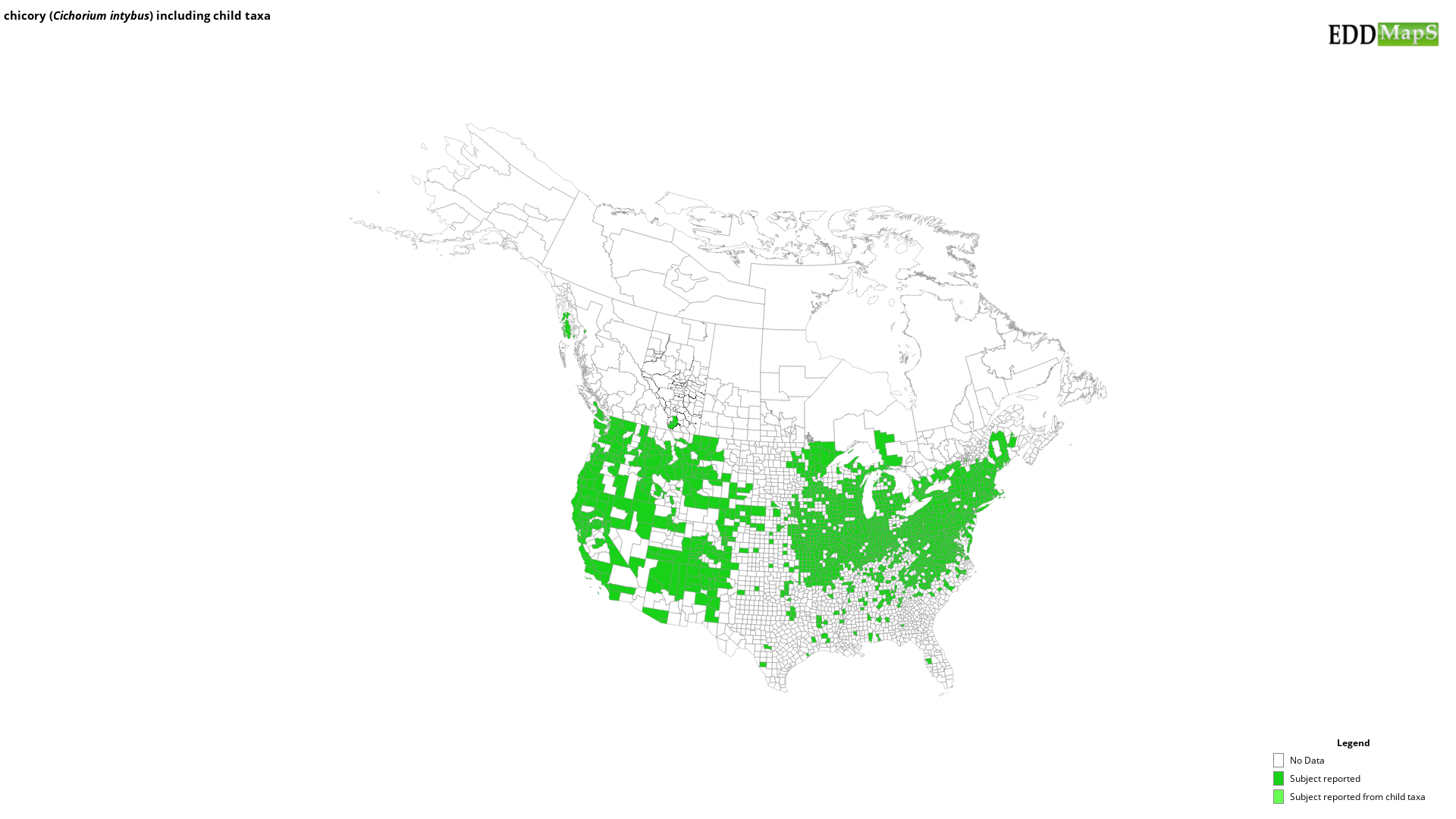chicory
(Cichorium intybus)
This species is Introduced in the United States
Appearance
Cichorium intybus is a biennial to perennial herbaceous plant that can grow from 1-5 ft. (0.3-1.5 m) tall. It has erect, round, hollow, nearly leafless, green to reddish-brown stems that produce a milky sap when cut. The lower part of the stems is hairy. It is native to Africa, both temperate and tropical Asia and Europe.
Foliage
Rosette leaves are 2-6 in. (5.1-15 cm) long, oblong with rough hairs on upper and lower surfaces. Margins may be shallowly toothed or deeply dissected. Lance-shaped stem leaves are small, sparse, alternate, and clasping with margins either smooth or slightly toothed.
Flowers
The flowers are in showy clusters on the upper branches. Each flower has bright blue petals with toothed squared-off ends. Flowers usually bloom in the morning and close later in the day.
Fruit
Fruits are about 0.13 in. (0.3 cm) long, dark brown, and wedge-shaped. Fruits contain one seed. Each plant can produce as many as 3000 seeds.
Ecological Threat
C. intybus prefers well-drained or moderately drained soils along roadsides, railroads, disturbed sites, waste ground, and cultivated fields. Although it is mostly limited to roadsides and waste places, it can encroach upon higher-grade dry prairie habitats. It is listed as a noxious weed in some states. C. intybus resembles native Showy Blue Lettuce (Mulgedium pulchellum).
Cichorium intybus is a biennial to perennial herbaceous plant that can grow from 1-5 ft. (0.3-1.5 m) tall. It has erect, round, hollow, nearly leafless, green to reddish-brown stems that produce a milky sap when cut. The lower part of the stems is hairy. It is native to Africa, both temperate and tropical Asia and Europe.
Foliage
Rosette leaves are 2-6 in. (5.1-15 cm) long, oblong with rough hairs on upper and lower surfaces. Margins may be shallowly toothed or deeply dissected. Lance-shaped stem leaves are small, sparse, alternate, and clasping with margins either smooth or slightly toothed.
Flowers
The flowers are in showy clusters on the upper branches. Each flower has bright blue petals with toothed squared-off ends. Flowers usually bloom in the morning and close later in the day.
Fruit
Fruits are about 0.13 in. (0.3 cm) long, dark brown, and wedge-shaped. Fruits contain one seed. Each plant can produce as many as 3000 seeds.
Ecological Threat
C. intybus prefers well-drained or moderately drained soils along roadsides, railroads, disturbed sites, waste ground, and cultivated fields. Although it is mostly limited to roadsides and waste places, it can encroach upon higher-grade dry prairie habitats. It is listed as a noxious weed in some states. C. intybus resembles native Showy Blue Lettuce (Mulgedium pulchellum).
Selected Images
Maps
EDDMapS Distribution - This map is incomplete and is based only on current site and county level reports made by experts, herbaria, and literature. For more information, visit www.eddmaps.org
State Lists - This map identifies those states that have this species on their invasive species list or law.
Invasive Listing Sources
- City of Ann Arbor Michigan Parks and Recreation
- Colorado Noxious Weeds
- Invasive Plant Species of West Virginia
- Jil M. Swearingen, Survey of invasive plants occurring on National Park Service lands, 2000-2007
- John Randall, The Nature Conservancy, Survey of TNC Preserves, 1995.
- Kentucky Exotic Pest Plant Council - Moderate Threat
- National Park Service, Mid-Atlantic Exotic Plant Management Team Invasive Plant List
- New Mexico Noxious Weeds
- Nonnative Invasive Species in Southern Forest and Grassland Ecosystems
- Pacific Northwest Exotic Pest Plant Council, 1998
- WeedUS - Database of Plants Invading Natural Areas in the United States
- West Virginia Native Plant Society, Flora West Virginia Project, and West Virginia Curatorial Database System, September 3, 1999
Taxonomic Rank
| Domain: Eukarya |
| Kingdom: Plantae |
| Phylum: Magnoliophyta |
| Class: Magnoliopsida |
| Superorder: Asteranae |
| Order: Asterales |
| Family: Asteraceae |
| Subfamily: Cichorioideae |
| Tribe: Cichorieae |
| Genus: Cichorium |
| Cichorium intybus |
Other System Links
Plants: CIIN
Bayer: CICIN
GRIN: 10543
ITIS: 36763
NPDN Pest: PBFAVBA
NPDN Host: 31719
References
Common Name Reference: USDA, NRCS. 2010. The PLANTS Database. National Plant Data Center, Baton Rouge, LA, USA.
Scientific Name Reference: USDA, NRCS. 2010. The PLANTS Database. National Plant Data Center, Baton Rouge, LA, USA.


